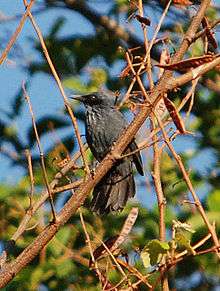Blue mockingbird
The blue mockingbird (Melanotis caerulescens) is a species of bird in the family Mimidae. It is endemic to Mexico, but has occurred as a vagrant in the southern United States. Its natural habitats are subtropical or tropical dry forests, subtropical or tropical moist montane forests, and heavily degraded former forest.
| Blue mockingbird | |
|---|---|
 | |
| Scientific classification | |
| Kingdom: | Animalia |
| Phylum: | Chordata |
| Class: | Aves |
| Order: | Passeriformes |
| Family: | Mimidae |
| Genus: | Melanotis |
| Species: | M. caerulescens |
| Binomial name | |
| Melanotis caerulescens (Swainson, 1827) | |
The blue mockingbird is uniformly blue on its back, tail, wings, head and underbelly. This color is a result of feather structure rather than pigment, and therefore can look gray in the shade. It has a black "mask" surrounding its reddish-brown eyes. It has a rather long, slightly graduated tail, and dark blue streaks over its breast. Its bill is long, thin and slightly curved, and its legs and feet are black.
Taxonomy
When he first described the blue mockingbird in 1827, William John Swainson assigned it to the mockingbird Orpheus, and when Orpheus became a junior synonym for the genus Mimus, the species was moved accordingly. Not all authorities agreed; several placed it in the thrush Turdus. However, when Charles Lucien Bonaparte moved it to its current genus Melanotis in 1850, most authorities quickly followed suit.[2] There is disagreement as to whether it is monotypic[3] or not.[4]
Among taxonomists who believe the species is polytypic, two subspecies are generally recognized.
- M. c. caerulescens, the nominate subspecies, is found in the pine-oak zone of western Mexico, from southern Sonora south to the Isthmus of Tehuantepec.
- M. c. longirostris is found only on the Tres Marías Islands, off the coast of western Mexico.[4]
The blue mockingbird has historically been considered conspecific with the closely related blue-and-white mockingbird.[5] Its species name is derived from the Latin adjective caerǔlěus, meaning "blue".[6]
Description
Measuring 9.5–10.5 in (24–27 cm) in length,[7] and weighing between 50.2 and 59.7 g (1.77 and 2.11 oz),[8] the blue mockingbird is a medium-sized mimid. Individuals of the subspecies caerulescens have a mean body mass slightly higher than that for individuals of the subspecies longirostris — 63.5 g (2.24 oz) for the former and 59.7 g (2.11 oz) for the latter.[8]
Habitat and range
The blue mockingbird lives in a variety of woodlands: humid forest, riparian thickets, scrub, pine-oak forests and second growth. It is found at elevations ranging from lowlands to 2,450 m (8,040 ft).[7]
Behavior
Food and feeding
The blue mockingbird is an omnivore; it feeds primarily on invertebrates, but also on some vegetable matter.[9]
Conservation and threats
Because of its very large range and sizable population (estimated to number 500,000–4,999,999 individuals), the blue mockingbird is rated as a species of least concern by the International Union for the Conservation of Nature. There is, however, evidence that its overall numbers are dropping, primarily due to habitat fragmentation and loss.[1] The Mexican government has named the longirostris subspecies as a taxon of "special concern".[10]
References
- BirdLife International (2012). "Melanotis caerulescens". IUCN Red List of Threatened Species. 2012. Retrieved 26 November 2013.CS1 maint: ref=harv (link)
- United States National Museum (1907). Bulletin of the United States National Museum, Volume 50, part 4. Washington, D.C.: Government Publishing Office. pp. 209–212.
- Monroe, Burt L; Sibley, Charles G (1997). A World Checklist of Birds. Yale University Press. p. 237. ISBN 0-300-07083-7.
- Clements, James F. (2000). Birds of the World: A Checklist (5th ed.). Robertsbridge, UK: Pica Press. p. 408. ISBN 1-873403-93-3.
- Sibley, Charles Gald; Monroe, Burt Leavelle (1990). Distribution and Taxonomy of the Birds of the World. Yale University Press. p. 522. ISBN 0-300-04969-2.
- Simpson DP (1979). Cassell's Latin Dictionary (5th ed.). London: Cassell Ltd. p. 84. ISBN 0-304-52257-0.
- Howell, Steve N.G.; Webb, Sophie (1995). A Guide to the Birds of Mexico and Northern Central America. Oxford University Press. p. 597. ISBN 0-19-854012-4.
- Dunning Jr., John B. CRC Handbook of Avian Body Masses (2nd ed.). Boca Raton, FL, US: CRC Press. p. 353. ISBN 978-1-4200-6444-5.
- Brewer, David (2010). Wrens, Dippers and Thrashers. London, UK: Christopher Helm. p. 210. ISBN 978-1-8734-0395-2.
- Wells, Jeffrey (2007). Birder's Conservation Handbook: 100 North American Birds at Risk. Princeton, NJ, US: Princeton University Press. p. 430. ISBN 978-0-691-12322-6.
External links
- Blue Mockingbird near Douglas, Arizona
- Blue Mockingbird at El Dorado Park in Long Beach, California
- Blue Mockingbird Images Arizona / El Dorado Park in Long Beach, California
- The Nature Writers of Texas- Welcome to the House of the Blue Mockingbird; Wednesday, December 17, 2003; Ron Smith, Valley Morning Star, December 17, 2003, © 2004
